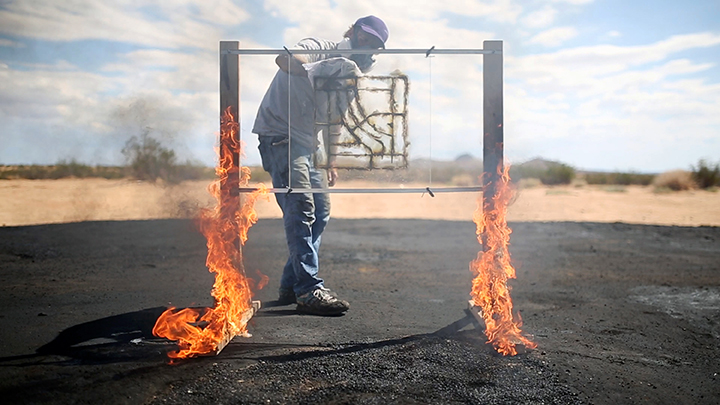






Jesse Sugarmann
California City
September 1–October 13, 2013
In his latest series of videos and objects titled California Bloodlines, Sugarmann maps, travels, and resurfaces the forgotten infrastructure of California City.
California City is the third largest city in California. Built on forty square miles of Mojave Desert in the early 1960’s, this planned community was built on speculation of an eastward jag of the thendeveloping California Aqueduct. The water never came, however, and so neither did the community. What remains is forty square miles of crumbling pavement, home to just over fifteen thousand residents in lieu of the millions it was designed to accommodate.
California City’s small population lives in the city’s center, a hamlet surrounded by a vastness of untended, unpopulated residential streets. Designed in mile square tracts, this shadow metropolis is slowly degrading back into desert, a vacant landscape populated only by off-road vehicles, recklessly vast bonfires, and the uncontested reports of Air Force weapons testing. The city, as it was planned, is ignored; the blank value of the desert outweighs the structured sprawl of civilization. In his series of videos and objects titled California Bloodlines, Jesse Sugarmann engages California City’s grid work as a physical presence of lost memory, unearthing the trappings of an incomplete history and unrealized past.
Sugarmann engages the present uses of the land by conducting his own weapons tests, using Napalm as a tool for making, and engaging in sad semblances of off-road motor sport. Through these efforts, Sugarmann finds the balance of structure and loss that is at the spirit of California City, approximating the social absence of a society that never materialized and fostering the remembrance of an unrealized past.
California City
September 1–October 13, 2013
In his latest series of videos and objects titled California Bloodlines, Sugarmann maps, travels, and resurfaces the forgotten infrastructure of California City.
California City is the third largest city in California. Built on forty square miles of Mojave Desert in the early 1960’s, this planned community was built on speculation of an eastward jag of the thendeveloping California Aqueduct. The water never came, however, and so neither did the community. What remains is forty square miles of crumbling pavement, home to just over fifteen thousand residents in lieu of the millions it was designed to accommodate.
California City’s small population lives in the city’s center, a hamlet surrounded by a vastness of untended, unpopulated residential streets. Designed in mile square tracts, this shadow metropolis is slowly degrading back into desert, a vacant landscape populated only by off-road vehicles, recklessly vast bonfires, and the uncontested reports of Air Force weapons testing. The city, as it was planned, is ignored; the blank value of the desert outweighs the structured sprawl of civilization. In his series of videos and objects titled California Bloodlines, Jesse Sugarmann engages California City’s grid work as a physical presence of lost memory, unearthing the trappings of an incomplete history and unrealized past.
Sugarmann engages the present uses of the land by conducting his own weapons tests, using Napalm as a tool for making, and engaging in sad semblances of off-road motor sport. Through these efforts, Sugarmann finds the balance of structure and loss that is at the spirit of California City, approximating the social absence of a society that never materialized and fostering the remembrance of an unrealized past.